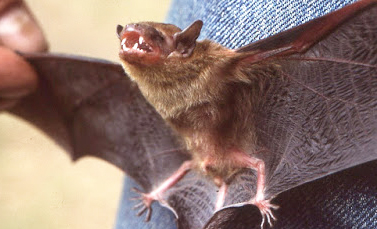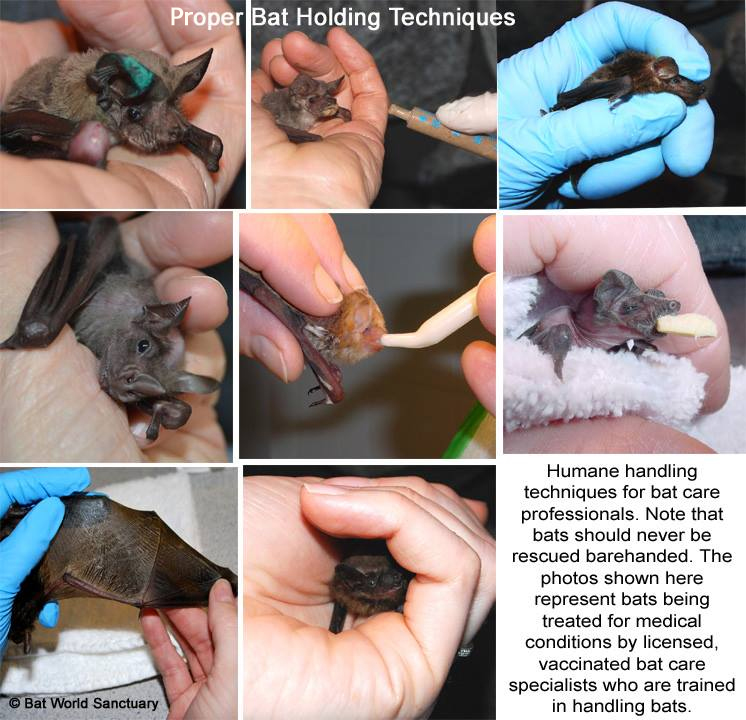Speaking Out Against Inhumane Handling Techniques
As the infamous panda bat picture has been making the rounds again recently, we’ve felt compelled to speak out about the inhumane way that bats are often held for research photographs. We are speaking out because most people by and large aren’t familiar with bats in general, much less their facial expressions. Given that these pictures are passed about so frequently in an admiring manner by people who love bats, we simply want others to understand that these animals are not being held so much as forcibly restrained for the photo.
Of course, it may necessary to restrain the bat to an extent; a wild animal doesn’t understand why it is being restrained. They likely only see a large predator who is capturing them. So when I characterize the pictures in question as showing bats being forcibly restrained, I’m referring more to the equivalent of someone twisting your arms painfully behind your back rather than a pain-free method of confinement.
Another reason we feel compelled to address these pictures as they arise is to get across that there are humane ways to do all of this. These more violent methods – and they are violent and not unlike the dangerous joint locks taught in various forms of martial arts, as both serve the same purpose, being to restrain a subject with pain and threat of serious injury if they resist – are presumably used due to fear and expediency. The comparison is valid both due to the pain that’s obvious to those familiar with bat behavior as well as the common, inadvertent injuries that result from such methods.

It’s important to know that Bat World Sanctuary is not anti-research, in fact, we are supportive of non-invasive/nonlethal research projects that benefit bats, and we have participated in studies of this nature, one of the most prominent on bat vocalizations. What we are against is the inhumane treatment of bats, and in pointing this out it seems to us that our points are indisputable: there are humane ways to handle bats that keep them restrained and take photographs. In fact, the end result of photographing a bat held humanely is a nice photo of a bat that appears normal in expression, which is much more beneficial in promoting bat conservation as a whole. Photos that show bats being held wings outstretched and by their incredibly delicate finger tips, or with their elbows pinned toward their backs in dangerous and agonizing positions, does little to promote bat conservation. In fact, photos like this ultimately mar the reputation of the researcher involved because it appears to the public that the handler would rather inflict pain and injury simply to save a few moments of time and possibly avoid being bitten. And if these handlers are afraid of being bitten, then they should simply stop being cowards, get vaccinated properly and accept that handling wild animals carries a risk of being bitten.
That said, handling bats humanely actually minimizes the likelihood of being bitten. It works on one simple principle; if an animal doesn’t feel as if there’s a dire threat, it significantly decreases its propensity to bite you. And bats aren’t stupid – they know they’ve been captured by gigantic creatures. We tower over them with lights and make strange noises and poke and prod them, gently or otherwise…they know they’re outmatched. If they don’t think there’s an imminent threat that you’ll directly injure them, they won’t pick a futile fight.

Some hard core researchers might wrongly assume that we take a fluffy approach to bat handling and care. For someone with a surface familiarity with animal rehab, this may seem like a valid critique. However, the bats in our captive colonies are all there for one broad reason: they cannot be released. Whether they are permanently injured, orphaned, or were simply born into the pet trade, Bat World sanctuary is all they have. Camaraderie and trust and affection behooves everyone concerned. We want the bats in our care to not feel as if it’s a life or death struggle if we handle them during health checks; we want them to feel safe enough to go back to sleep if we accidentally wake them up as we go about our work.
But past the pragmatic aspects of it, our overriding concern is to provide a safe, rich environment for them to spend their lives. It’s a basic respect for life. That such a thing could be called fluffy should strike us all as very, very sad.
In closing, we simply consider that there is no reason for any researcher to inflict pain on any living thing. If pressed and not allowed to evade that basic question, even they couldn’t honestly disagree with this point. Science and humanity aren’t mutually exclusive. Researchers who opt to be inhumane out of expediency and an unwillingness to accept the risks of handling wild animals should be exposed for this practice. Our hope is that when exposed, they might put forth the extra effort to carry out their research with more respect for their subjects.

